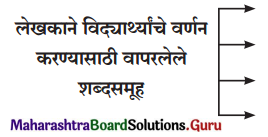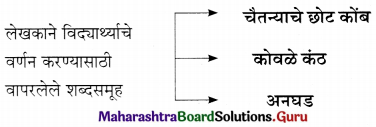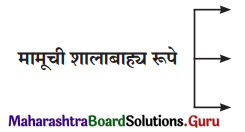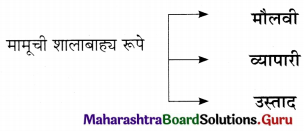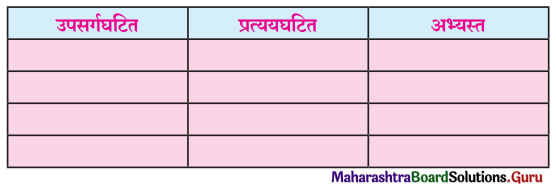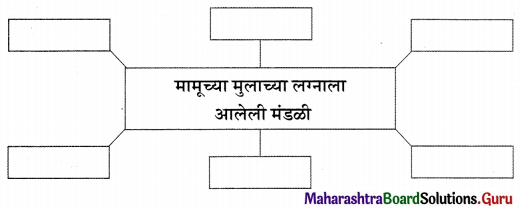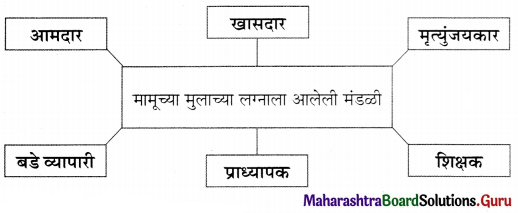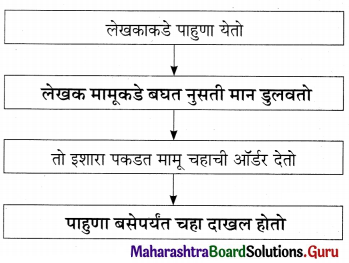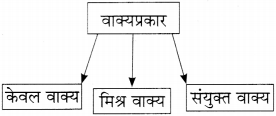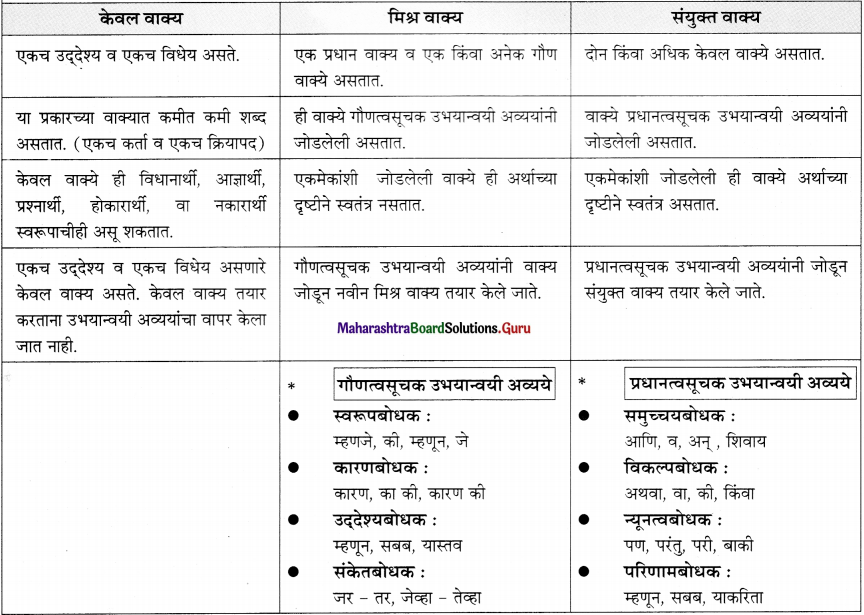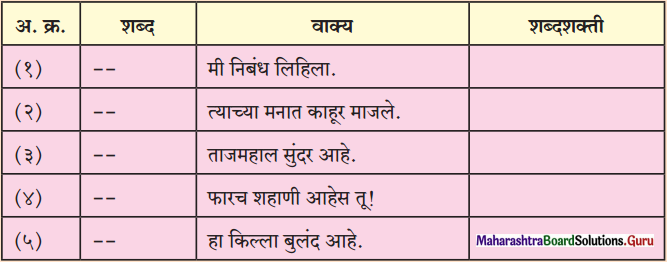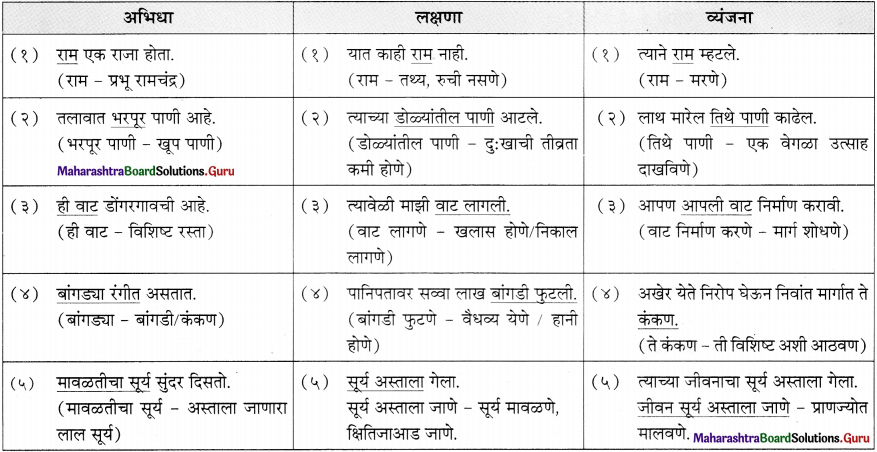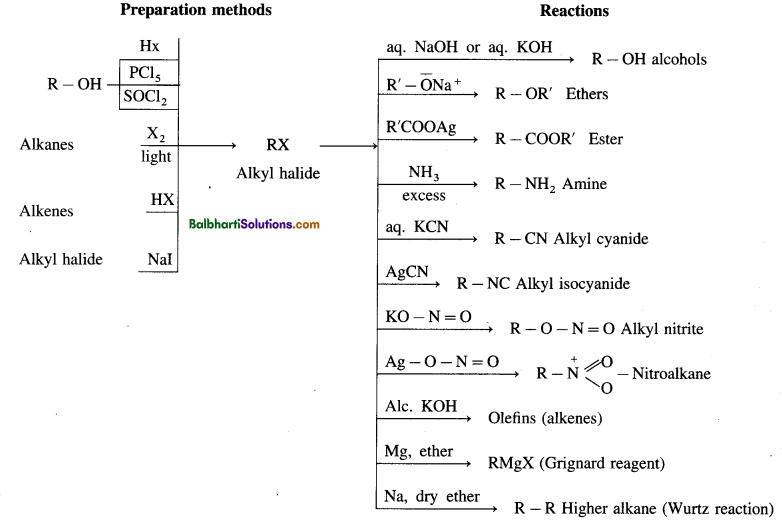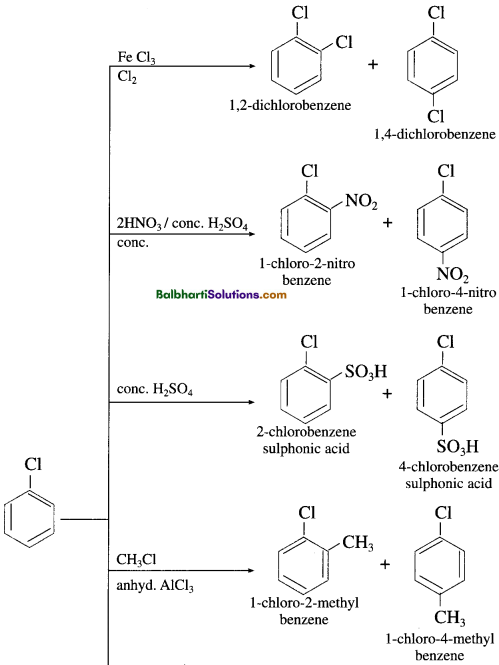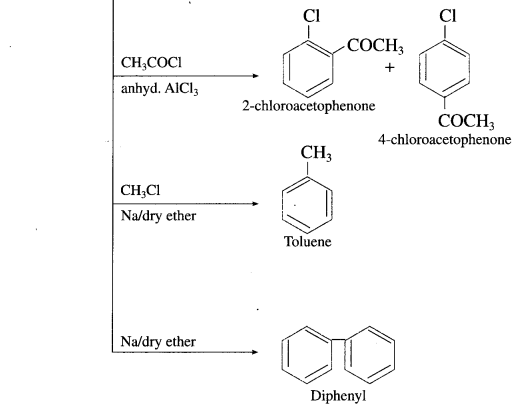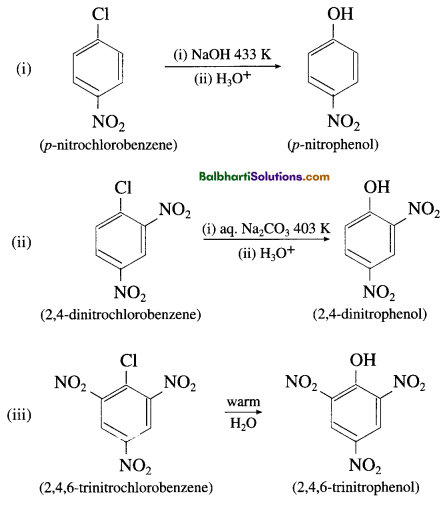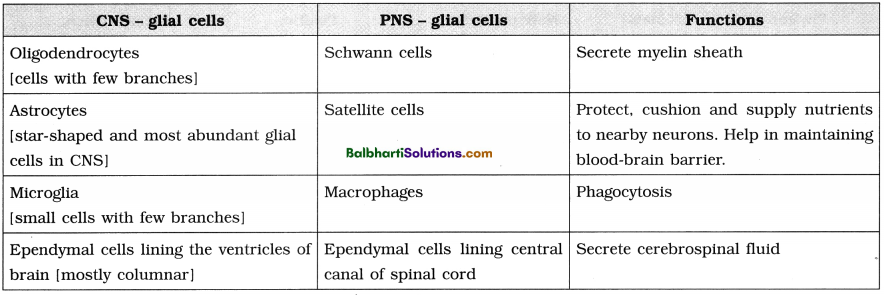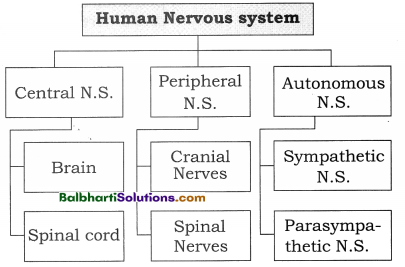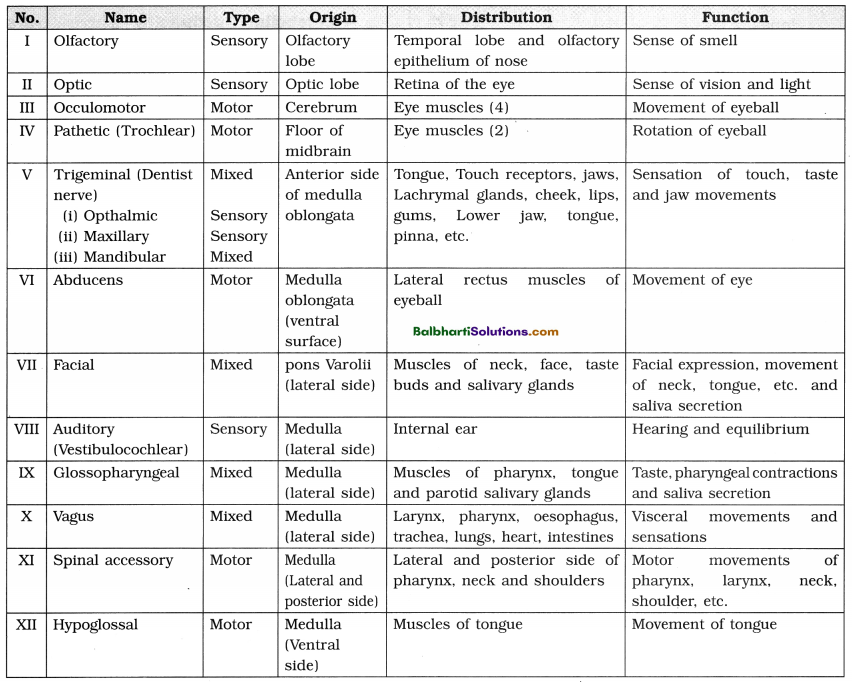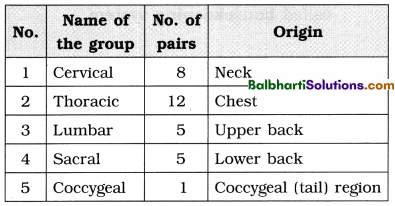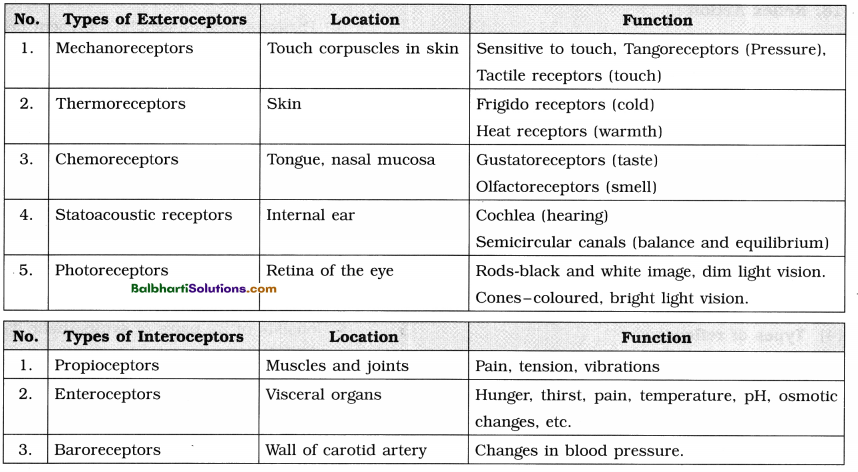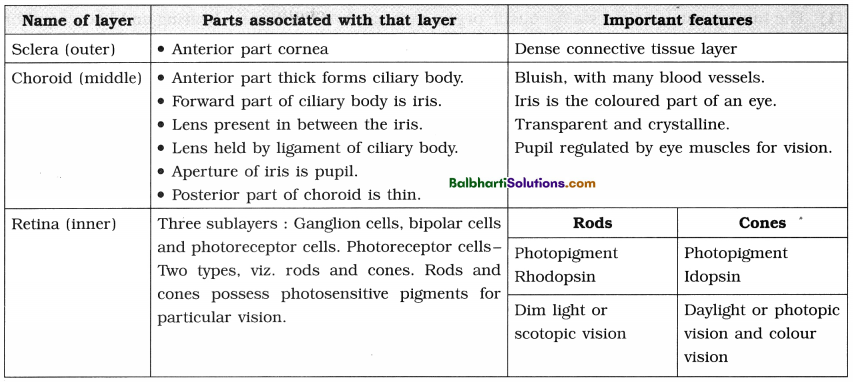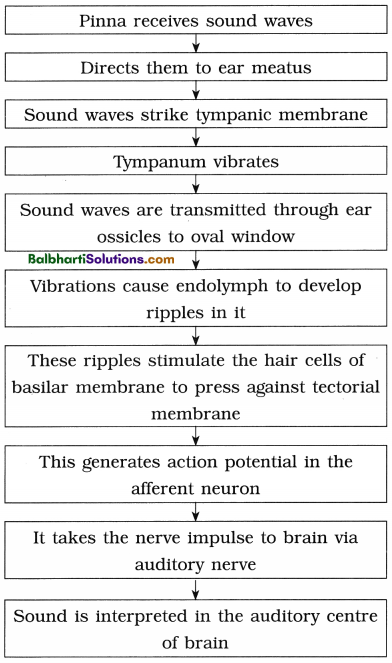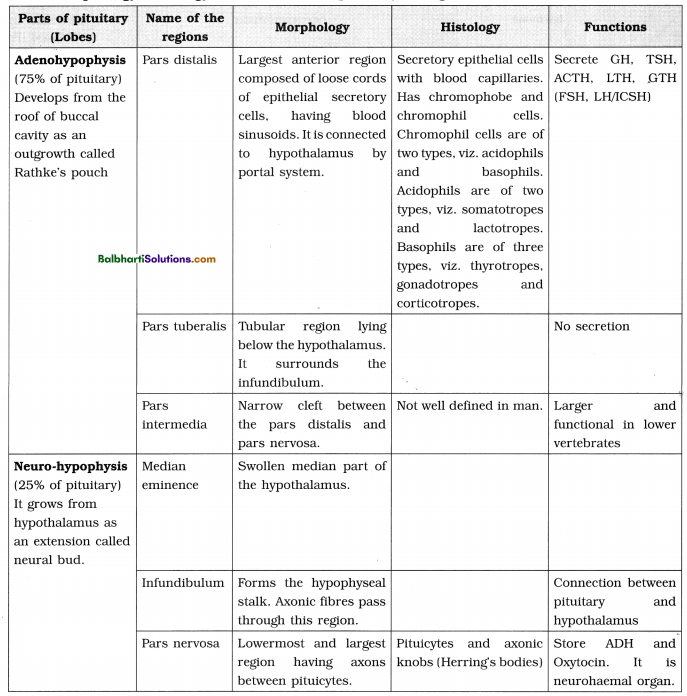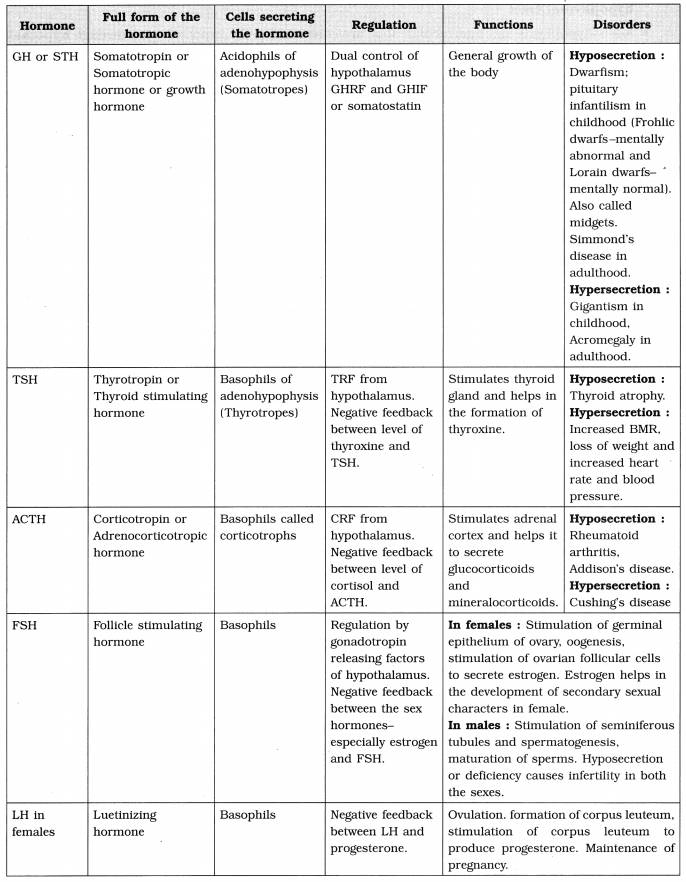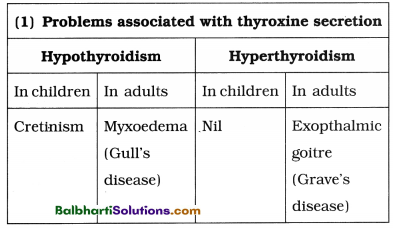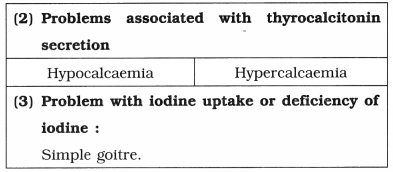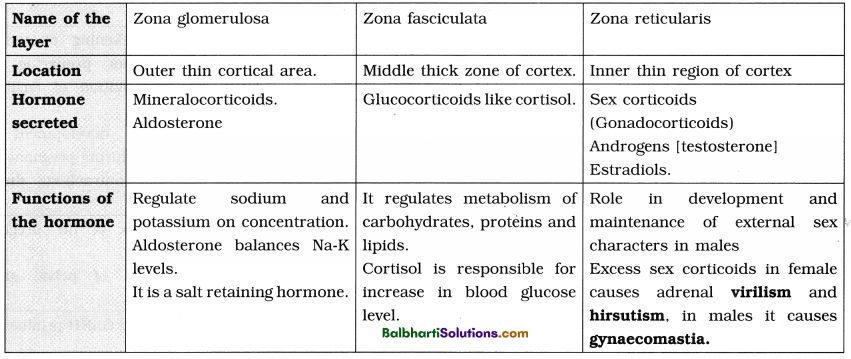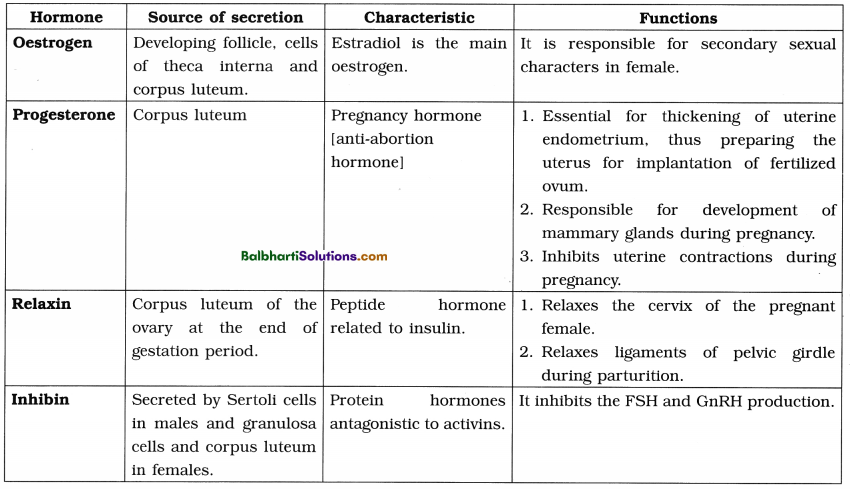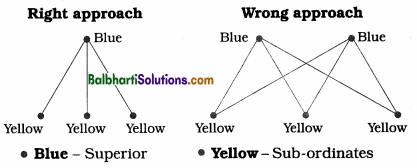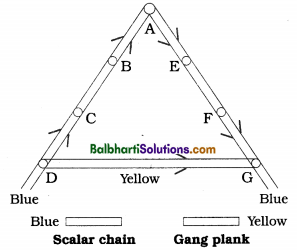Balbharti Maharashtra State Board Marathi Yuvakbharati 11th Digest Chapter 2 प्राणसई Notes, Textbook Exercise Important Questions and Answers.
Maharashtra State Board 11th Marathi Yuvakbharati Solutions Chapter 2 प्राणसई
11th Marathi Digest Chapter 2 प्राणसई Textbook Questions and Answers
कृती
1. अ. चौकटी पूर्ण करा.
प्रश्न 1.
- कवयित्रीने जिला विनंती केली ती – [ ]
- कडाडत्या उन्हाला दिलेली उपमा – [ ]
- कवयित्रीच्या मैत्रिणीला सांगावा पोहोचवणारी – [ ]
- शेतात रमणारी व्यक्ती – [ ]
उत्तर :
- कवयित्रीने जिला विनंती केली ती – प्राणसई
- कडाडत्या उन्हाला दिलेली उपमा – राक्षसी
- कवयित्रीच्या मैत्रिणीला सांगावा पोहोचवणारी – पाखरे.
- शेतात रमणारी व्यक्ती – सखा.
आ. कारणे लिहा :
प्रश्न 1.
बैलांचे मालक बेचैन झाले आहेत;
उत्तर :
बैलांचे मालक बेचैन झाले आहेत; कारण पावसाअभावी बैल ठाणबंद झाले आहेत.
![]()
प्रश्न 2.
बाळांची तोंडे कोमेजली;
उत्तर :
बाळांची तोंडे कोमेजली; कारण त्यांच्या तोंडाला उन्हाच्या झळा लागत आहेत.
इ. कृती करा.
प्रश्न 1.
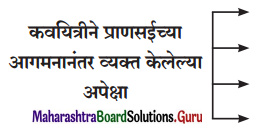
उत्तर :

2. अ. खालील काव्यपंक्तींचा अर्थ स्पष्ट करा.
प्रश्न 1.
विहिरीच्या तळीं खोल दिसू लागलें ग भिंग :
उत्तर :
कडाक्याच्या उन्हामुळे भूमी करपून गेली, नदया, विहिरीदेखील आटून गेल्या. विहिरीच्या तळाला अगदी कमी पाणी राहिल्यामुळे ते अगदी भिंगासारखे दिसू लागले आहे. भिंगाचा वापर केल्यावर कोणतीही छोटी गोष्ट मोठी दिसू लागते. इथे पाणी विहिरीच्या तळाशी गेले यावरून पाण्याची समस्या किती मोठं रूप धारण करणार आहे याची जाणीव कवयित्री व्यक्त करते.
प्रश्न 2.
ये ग दौडत धावत आधी माझ्या शेतावर
उत्तर :
पाऊस न आल्यामुळे सगळं वातावरण बिघडून गेले आहे. वातावरण तप्त झालेले आहे, म्हणून कवयित्री आपल्या प्राणसईला मैत्रीखातर बोलावत आहे. या प्राणसईने दौडत धावत आपल्या शेतावर यावं असं वाटतं. शेतात धान्याची बीज पेरलेली आहेत त्यांना वेळेवर पाणी मिळालं नाही तर ती सुकून जातील, शेतातील पिकावरच अवघं जग जगत असते. म्हणून कवयित्री आपल्या शेतावर येण्याचं निमंत्रण पावसाच्या सरींना देते.
![]()
प्रश्न 3.
तशी झुलत झुलत ये ग माझिया घराशीं:
उत्तर:
प्राणसई असलेल्या पावसाच्या सरींनी भूमीवरच्या सर्वांना भेटायला यावे असे कवयित्रीला वाटते. ती यावी याकरता ती पाखरांसवे प्राणसई पावसाला निरोप पाठवत आहे. त्या पावसाच्या सरींनी गार वाऱ्यासवे झुलत झुलत आपल्या समवेत यावे असे कवयित्रीला वाटते. त्या पावसाच्या सरींनी आपले घरही चिंब भिजावे असं मनोमन तिला वाटते.
आ. खालील तक्त्यात सुचवल्याप्रमाणे कवितेच्या ओळी लिहा.
प्रश्न 1.
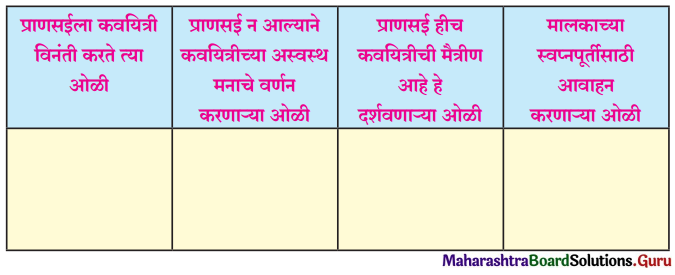
उत्तर :
| प्राणसईला कवयित्री विनंती करते त्या ओळी | प्राणसई न आल्याने कवयित्रीच्या अस्वस्थ मनाचे वर्णन करणाऱ्या ओळी | प्राणसई हीच कवयित्रीची मैत्रीण आहे हे दर्शवणाऱ्या ओळी | मालकाच्या स्वप्नपूर्तीसाठी आवाहन करणाऱ्या ओळी |
| ये गये ग घनावळी मैत्रपणा आठवून …… | प्राणसई घनावळ कुठे राहिली गुंतून ? | मन लागेना घरांत : कधी येशील तू सांग ? | शेला हिरवा पांघरमालकांच्या स्वप्नांवर |
3. काव्यसौंदर्य
अ. खालील ओळीतील भावसौंदर्य स्पष्ट करा.
प्रश्न 1.
‘कां ग वाकुडेपणा हा,
कांग अशी पाठमोरी?
वाऱ्यावरून भरारी.
ये ग ये ग प्राणसई’
उत्तर :
कवयित्री इंदिरा संत या पावसाच्या सरींना घनावळींना आपली मैत्रीण मानतात. या मैत्रिणीने आता फार विसावा घेतला. तिच्या भेटीची आतुरता कवयित्रीला लागून राहिली आहे. पण ही हट्टी घनावळी मात्र पाखरांसवे निरोप पाठवून, विनवणी करूनही येत नाही, त्यामुळे कवयित्रीचा जीव कासावीस होतो. शेतात बैल काम करेनासे झाले आहेत, तान्हुल्या बाळांचे चेहरे उन्हाच्या झळांमुळे सुकून गेले आहेत.
नदीचे, विहिरीचे पाणी आटू लागले आहे. अशी जीवघेणी परिस्थिती पाऊस वेळेवर न आल्यामुळे झाली आहे. जर हा पाऊस आपला सखा आहे असं आपण म्हणतो, जर ती सखी आहे असं कवयित्रीला वाटतं तर तिनं फार आढेवेढे न घेता आपल्या सख्यांना भेटायला यायला हवे. तिच्यावर अवधी सृष्टी अवलंबून आहे. त्यांचे प्राण कंठाशी येईपर्यंत तिने वाट पाहू नये. त्यामुळे कवयित्रीला वाटतेय की या प्राणसईने वाकडेपणा सोडावा, राग, रुसवा सोडावा. पाठमोरी होकन राग रुसवा धरून मनं व्याकूळ करण्यापेक्षा वायसवे धावत ये. सगळ्यांना चिंब कर. इतरांना सुख देण्यातच आनंद असतो.
![]()
प्रश्न 2.
‘शेला हिरवा पांघर
मालकांच्या स्वप्नावर’.
उत्तर :
प्राणसईने या वर्षी भेटीसाठी विलंब केल्यामुळे सगळेचजण हवालदिल झाले आहेत. जमीनही तप्त झाली आहे. शेतकऱ्यांनी आपली कर्तव्ये पूर्ण केली आहेत. कवयित्रीचा सखाही शेतकरी आहे. प्राणसई धावून आली की संपर्ण शेत हिरवेपणाने भरून जाईल. हिरवेपणाचा शेला (शाल) धरतीवर पांघरला जाईल. अवधी सृष्टी चैतन्यमय होईल. तिचं सोबत असणं गरजेचं आहे. मालकाची स्वप्नंही तिच्यावर अवलंबन आहेत. ही घनावळी आली की पिके जोमानं वाढतील. घरीदारी आनंद निर्माण होईल. आपल्या घरात, देशात आपल्या कष्टामुळे आनंद मिळावा हे मालकाचं स्वप्नं पूर्ण होईल.
आ. कवयित्रीने उन्हाळ्याच्या तीव्रतेचे वर्णन करताना योजलेली प्रतीके स्पष्ट करा.
प्रश्न 1.
पीठ कांडते राक्षसी –
उत्तर :
उन्हामुळे सगळीकडे तप्त झालेले वातावरण (राक्षसी) प्रतीक
प्रश्न 2.
बैल झाले ठाणबंदी
उत्तर:
उन्हाची तीव्रता अधिक झाल्यामुळे बैलही काम करेनासे झाले. (ठाणबंदी) प्रतीक
![]()
प्रश्न 3.
तोंडे कोमेली बाळांची
उत्तर:
उन्हाच्या झळांमुळे बाळांची तोंडे कोमेजली आहेत. (कोमेली) प्रतीक,
इ. कवयित्री आणि प्राणसई यांच्यातील नाते जिव्हाळ्याचे आहे, स्पष्ट करा.
प्रश्न 1.
कवयित्री आणि प्राणसई यांच्यातील नाते जिव्हाळ्याचे आहे, स्पष्ट करा.
उत्तर:
कवयित्री इंदिरा संत यांची प्राणसई घनावळी आहे म्हणजे पावसाच्या सरी आहेत. ही घनावळी कवयित्रीची प्राणसखीच आहे. तिच्या भेटीसाठी कवयित्री आतुर झालेली आहे. कवयित्रीने अगदी हक्काने तिला भेटण्यासाठी आमंत्रणं पाठवली आहेत. प्राणसई कुठे तरी गुंतून राहिली याबाबत कवयित्री काळजी व्यक्त करते.
पाखरांच्या हाती तिने या घनावळीला निरोप पाठवला आहे. आपला मैत्रपणा आठवून तिनं दौडत यावं असं कवयित्रीला वाटत आहे. ती आल्याशिवाय आपल्याला चैन पडत नाही असंही ती म्हणते. आपल्या या सखीने येऊन शेत, घरं, दारं यांना चिंब भिजवावं असं हक्काने सांगते असा हक्क मैत्रीतच दाखवता येतो. ही सखी आल्यानंतर तिने कितीही आढेवेढे घेतले तरी कवयित्री तिला समजावून सांगणार आहे की तिचे येणे या भूतलावर किती महत्त्वाचे आहे ते. तिच्याशी गप्पा मारून आपल्या सख्याचे कौतुक ती सांगणार आहे.
4. अभिव्यक्ती:
प्रश्न अ.
तुमच्या परिसरातील पावसाळ्यापूर्वीच्या स्थितीचे वर्णन करा.
उत्तर :
मी मुंबईतील एका चाळीत राहतो. मार्च ते मे महिन्याचा कालावधी मुंबईकरांच्या दृष्टीने त्रासदायक असतो. मार्चपासून जो तीव्र उन्हाळा सुरू होतो तो जूनच्या शेवटच्या आठवड्यापर्यंत अनुभवतो. उन्हामुळे जीवाची काहिली होते त्यात वीजपुरवठा मधून मधून जात असतो. काही विभागात तर पाणीपुरवठाही कमी असतो. दोन दिवसाआड पाणी आले की ते पाणी भरण्यासाठी माणसांची झुंबड उडते. घामाच्या धारा इतक्या वाहू लागतात की घरात ए.सी., पंखा लावून शांत बसावं असं वाटतं. याच काळात परीक्षा असतात. विदयाथ्यांचे वीज नसल्यामुळे हाल होतात. इथल्या वातावरणाला कंटाळून गावालाही जातात.
![]()
प्रश्न आ.
पावसानंतर तुमच्या परिसरात होणाऱ्या बदलाचे वर्णन करा.
उत्तर :
उन्हाळ्यामुळे वैतागून गेलेला जीव पावसाची आतुरतेने वाट पहात असतो. पावसाच्या आधी महानगरपालिकेने साफसफाईची धोरणं आखून काम केलेलं असत, आमच्या विभागात आम्ही नागरिक चाळीची कौलं, घरांची छप्परं यांची दुरुस्ती करून घेतो. पाऊस आल्यानंतर सुखद गारवा सगळीकडे पसरतो, ओलीचिंब झालेली धरणी, त्यावर चढू लागलेली हिरवळ मनाला आनंद देते. जोरजोरात पाऊस पडताना कौलांतून गळणारे पाणी अडवण्यासाठी आमची जाम धावपळ होते. कधीकधी आमच्या विभागात पाणीदेखील साठतं, मग त्यांना मदत करण्यासाठी अख्खी वस्ती पुते येते, गटार, नाले यांचा दुर्गध सर्वत्र पसरतो आणि नंतरचे काही दिवस रोगराईला सामोरं जावं लागतं. मैदाने, रस्ते यांच्यावर फेकलेला कचरा त्यातून निघणारा कुबट वास जीव नकोसा करतो. आधी हवाहवा वाटणारा पाऊस अशावेळी मात्र नकोसा वाटू लागतो.
प्रश्न इ.
पावसानंतर कोणाकोणाला कसाकसा आनंद होतो ते लिहा.
उत्तर:
पाऊस म्हणजे आनंद, तृप्ती, मलाही पाऊस आवडतो. पावसानंतर सर्वात जास्त आनंद होत असेल तर कोणाला ? धरित्रीला. हो. पृथ्वीला. आठ महिन्यांच्या विश्रांतीनंतर पृथ्वीलाही त्याला भेटण्याची ओढ लागलेली असते. पावसानंतर सष्टीला चैतन्य प्राप्त है भरभरून वाहू लागतात. त्यामुळे पाण्याचा प्रश्न काही अंशी संपलेला असतो. मुंबईतील तलाव भरले गेले की मुंबईकर आपल्याला वर्षभर पाणी मिळेल- या आशेने आनंदीत होतात. बळीराजा जो सातत्याने कष्ट करत असतो त्याच्या शेतात आता धनधान्य पिकणार असतं. पाऊस हा अशी आनंदाची पर्वणी घेऊन आलेला असतो.
5. रसग्रहण.
प्रश्न 1.
‘प्राणसई’ या कवितेचे रसग्रहण करा.
उत्तर:
कवयित्री इंदिरा संत या मराठी साहित्यविश्वातील एक ख्यातनाम ज्येष्ठ कवयित्री आहेत. प्राणसई ही त्यांची कविता पावसाला उद्देशून आहे. उन्हाळ्यामुळे वातावरण तापलेले आहे. राक्षसासारखे ऊन कडाडले आहे. ते अक्षरशः वातावरणाचे पीठच काढते आहे. तीव्र उन्हाळ्याचे चटके कोणालाही सहन होईनासे झाले आहेत हे एका प्रतीकातून इंदिराबाई स्पष्ट करतात ‘पीठ कांडते राक्षसी पीठ कांडते’ हे कष्टमय काम पण ते भरपूर प्रमाणात केले जाते तेव्हा त्याला राक्षसी म्हटले जाते. अशावेळी प्राणसई म्हणजे पाऊस कुठे बरी गुंतून राहिली? असा प्रश्न कवयित्रीला पडतो.
सई म्हणजे सखी हा शब्द योजताना कवयित्रीच्या मनात पाऊस हा सगळ्यांचाच प्राण आहे त्यामुळे कवयित्रीने प्राणसई ही उपमा पावसासाठी उपयोजिली आहे. प्राणसईने भेट दयायला फारच दिरंगाई केली त्यामुळे कवयित्रीने आपल्या सखीला भेटण्याकरता पाखरांसवे बोलावणे पाठवले आहे, या पावसांच्या सरींना ती घनावळी म्हणतेय, व्याकूळ मनाला घनावळीच साद देऊ शकतात. आपल्यातील सख्य, मैत्रपणा आठवून आता या पृथ्वीवर धावत ये, दौडत ये अशी विनवणी कवयित्री करत आहे.
प्राणसखी धनावळी भेटायला येण्याचा काळ ओसरून गेला परंतु ती आली नाही.पाऊस आला की सगळे वातावरण ओले चिंब होते. भाज्या, धान्य यांच्या बी-बियाण्यांच्या आळी जमिनी भाजून करून ठेवल्या आहेत. ती आली की या बियाण्यांमधून रोपे तयार होतील आणि त्याच्या वेली सर्वत्र पसरतील, पावसाळ्यात डासांचा, कीटकांचा त्रास होतो. अशावेळी शेणकुळी जाळल्या जातात.
त्यासाठी घरातील कोपरा रिकामा करून तिथे शेणी ठेवल्या आहेत. तीव्र उन्हाळ्यामुळे बैलही ठाणबंदी झाले आहेत. कामासाठी ते तयार नसल्यामुळे मालकालाही काहीच सुचेनासे झाले आहे. तप्त झालेल्या धरणीतून गरम वाफा येतात त्यामुळे वाराही तप्त झालेला आहे. वरून उन्हें आग ओकत आहेत. याचा परिणाम कोवळ्या जीवावरही होऊ लागला आहे. लहान बाळांचे कोवळे जीव कासावीस झाले आहेत. त्यांचे चेहरे कोमेजून गेले आहेत हे स्पष्ट करताना कवयित्री ‘तोंडे कोमेली बाळांची’ अशी रचना करते.
उन्हाळ्याचे चार महिने संपले की आपसूकच ओढ लागते पावसाची. पण पावसाचे दिवस सुरू झाले असताना पावसाची’ एकही सर आली नाही त्यामुळे व्याकुळलेली कवयित्री आपल्या पाऊस सखीला पृथ्वीवर येण्यासाठी विनवणी करते आहे. ती प्राणसई न आल्यामुळे विहिरीचे पाणीदेखील अगदी तळाशी गेले आहे. ते भिंगासारखे दिसू लागले आहे.
असं कवयित्री म्हणते. भिंग ज्याप्रमाणे सूक्ष्म असलेली गोष्ट मोठी करून दाखवते त्याप्रमाणे हे पाण्याचे भिंगदेखील येणाऱ्या सूक्ष्म संकटाची चाहूल देत आहे असे कवयित्रीला वाटत आहे. हे संकट भीषण रूप धारण करायच्या आगोदर माझ्या घरी, शेतावर तू दौडत ये असं कवयित्री पाऊस धारेला विनवणी करते, तू आलीस की आमच्या या शेतावर हिरवळ येईल, मातीत ओलावा येईल आणि मातीतील बी-बियाण्यांना अंकुर फुटेल. मालकांच्या मनातीलही स्वप्नं पूर्ण होतील.
पावसाच्या सरी वायसवे झुलत-सुलत येतात म्हणून कवयित्री म्हणते की तू वाऱ्यासोबत झुलत झुलत माझ्या घरापाशी ये. माझ्या घराजवळ आलीस की माझी पोरं तुझ्या पावसाच्या सरींना झोंबतील. इथे कवयित्री पावसाच्या धारा-सरी यांना जरीची उपमा देते. सोनेरी जरीमध्ये स्वतःची ताकद असते, ती सहसा तुटत नाही. ती मौल्यवान असते. तसंच ही पावसाची सरही मौल्यवान आहे. तिच्या जरीचा घोळ म्हणजे पावसाचे साठलेले पाणी या पाण्यात कवयित्रीची पोरं खेळतील.
भोपळ्याची, पडवळाची आळी, मालकाने कधीपासून तयार करून ठेवली आहेत. प्राणसईच्या येण्याने ती भिजतील, त्यांना कोंब फुटेल. तू आलीस की तुझ्या जलसाठ्याने त्या विहिरींना पण तुडुंब भर. घरदार संपूर्ण सृष्टी चिंब भिजायला हवी आहे कारण पाण्याविना काहीच चैतन्य नाही. अशी धावत धावत ही प्राणसई आली की कवयित्री तिच्यासोबत खप गप्पा मारणार आहे. तिच्याशी आपल्या सख्याच्या गजगोष्टी सांगणार आहे. त्याचं कौतुक आपल्या मैत्रिणीला सांगताना तिला अभिमान वाटणार आहे.
पावसाच्या या धनावळीने आता वाकडेपणा सोडावा आणि भूतलावर अगदी तीव्रतेने धावत यावं असं कवयित्रीला वाटतं. आमच्या सगळ्यांकडे अशी पाठ करून तू काय साधशील बरं? असा त्रास देण्यापेक्षा प्रेमानं तुझ्या धारांमध्ये भिजवलंस तर सगळेजण आनंदी होतील. च मिळेल, त्यामुळे वाऱ्यावर भरारी मारून अगदी लवकर भेटीयला ये अशा आत्यंतिक जिव्हाळयाने कवयित्री आपल्या सखीला बोलावते.
![]()
शब्दसंपत्ती.
प्रश्न 1.
खालील शब्दांचे समानार्थी शब्द शोधून शब्दमनोरा पूर्ण करा.
उदा.,
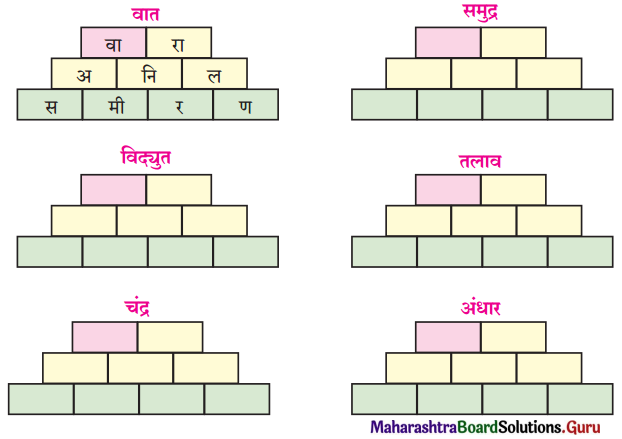
उत्तर:
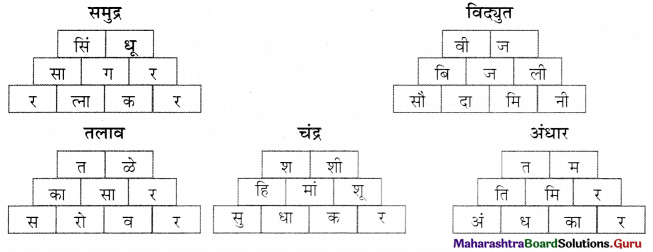
11th Marathi Book Answers Chapter 2 प्राणसई Additional Important Questions and Answers
चौकटी पूर्ण करा.
प्रश्न 1.
- विहिरीच्या तळी दिसू लागले ते – [ ]
- घनावळीने हिचा मैत्रपणा आठवावा – [ ]
- प्राणसईने वाऱ्यासोबत असे यावे – [ ]
उत्तर:
- भिंग
- मैत्रिणीचा
- भरारी मारून
![]()
कारणे लिहा.
प्रश्न 1.
पाखरांच्या हाती पावसाला सांगावा धाडला, कारण – ……….
उत्तर:
पाखरांच्या हाती पावसाला सांगावा धाडला, कारण पावसाने यायला उशीर केला म्हणून लवकर यावे.
प्रश्न 2.
पडवळा – भोपळ्यांची आळी ठेविली भाजून, कारण – ………
उत्तर:
पडवळा – भोपळ्यांची आळी ठेविली भाजून, कारण या भाज्यांची लागवड करावयाची आहे.
कृती करा.
प्रश्न 1.
प्राणसई आल्यावर कवयित्री या गोष्टी करेल – …………..
उत्तर :
प्राणसई आल्यावर कवयित्री या गोष्टी करेल – दारात उभी राहून तिच्याशी आपल्या सख्याबददलच्या गप्पा सांगेल.
प्रश्न 2.
सखा रमला शेतांत त्याचे कौतुक सांगेन:
उत्तर :
पावसाची वाट पाहणं हे शेतकऱ्याच्या पाचवीला पूजलेलं असत. कवयित्रीचा सखा शेतकरी आहे, त्याने काबाडकष्ट करून पेरणी केलेली आहे.
पाऊस न आल्यामुळे तो सुद्धा चिंतेत पडला आहे. शेत, अन्नधान्य, घर हेच त्याचं विश्व आहे. त्यामुळे तो त्यात रमतो, कष्ट करतो. याचं
कौतुक कवयित्रीला आहे. त्यामुळे कवयित्रीला आपल्या सख्याचे कौतुक आपल्या प्राणसईला सांगावेसे वाटत आहे.
![]()
आकलन कृती :
चौकटी पूर्ण करा.
प्रश्न 1.
मालक बेचैन झाले कारण – [ ]
उत्तर:
मालक बेचैन झाले कारण – तीव्र उन्हाळ्यामुळे बैल कामासाठी तयार नाहीत म्हणून
प्रश्न 2.
विहिरीच्या तळाशी भिंग दिसू लागले कारण – [ ]
उत्तर:
विहिरीच्या तळाशी भिंग दिसू लागले कारण – पाऊस न आल्याने विहिरीचे पाणीदेखील तळाशी गेले आहे.
जोड्या लावा.
प्रश्न 1.
| आळी ठेविली | सजवून |
| शेणी ठेविल्या | भाजून |
| रचून |
उत्तर:
आळी ठेविली – भाजून
शेणी ठेविल्या – रचून
![]()
उपयोजित कृती :
खालील पठित पदय पंक्तींच्या आधारे दिलेल्या सुचनेनुसार कृती करा.
खालील शब्दांपासून अर्थपूर्ण शब्द तयार करा.
प्रश्न 1.

उत्तर :

आकृती पूर्ण करा.
प्रश्न 1.

उत्तर:

प्रश्न 2.
बैलांच्या अगतिक झालेल्या अवस्थेसाठी कवयित्रीने उपयोजिलेला शब्द –
उत्तर :
बैलांच्या अगतिक झालेल्या अवस्थेसाठी कवयित्रीने उपयोजिलेला शब्द – ठाणबंदी
क्रमवारी लावा.
प्रश्न 1.
- झाले मालक बेचैन
- झळा उन्हाच्या लागून
- तोंड कोमेली बाळांची
- बैल झाले ठाणबंदी
उत्तर:
- बैल झाले ठाणबंदी
- झाले मालक बेचैन
- तोंड कोमेली बाळांची
- झळा उन्हाच्या लागून
![]()
काव्यसौंदर्य:
प्रश्न 1.
‘तोंडे कोमेली बाळांची
झळा उन्हाच्या लागून
या पक्तीतील भावसौंदर्य स्पष्ट करा.
उत्तर :
कवयित्री इंदिरा संत यांच्या प्राणसई कवितेत पावसाच्या आगमनापूर्वीच्या स्थितीचे वर्णन केलेले आहे. उन्हाने तप्त झालेल्या वातावरणाचे परिणाम लहान तान्हुल्या बाळांनाही सोसावे लागत आहे. त्यांच्याही जीवाची काहिली झाली आहे. त्यांची कोवळी तोंडे, कोमेजून गेली आहेत. त्या कोवळ्या चेहऱ्यांचा कोमेजून जाळ्याची उल्लेख करताना कवयित्री कोमेली ही नवीन सौंदर्य प्रतिमा वापरतात त्यामुळे त्या तान्हुल्या बाळांच्या चेहऱ्यावरील कोमल भाव प्रकट होतात.
स्वमतः
प्रश्न 1.
पावसाच्या आगमनासाठी तुम्ही कसे आतुर असता?
उत्तर :
पावसाळा हा ऋतू माझा सर्वात आवडीचा ऋतू. पाऊस कधीही यावा आणि त्यात चिंब भिजावे अशी माझी मनस्थिती असते. उन्हाळ्याचे चार महिने सोसल्यावर, त्याची दाहकता अनुभवल्यावर साहजिकच मनाला ओढ लागते ती पावसाची. पहिला पाऊस पडल्यानंतर मातीच्या सुगंधालाही मी आसुसलेला असतो. कॉलेजच्या पहिल्याच दिवशी भरपूर पाऊस पडावा असं खूप वाटत असतं. पावसाळ्यात ट्रेकिंगला जायला मला प्रचंड आवडतं. निसर्गाच्या सानिध्यातील भटकंती मला माझ्यातील खुजेपण शोधायला भाग पडते. निसर्ग भरभरून देतो. आपण केवळ त्याचा आनंद घेतो त्याला काही देत नाही. त्याला वाचवण्याचा प्रयत्न करण्यासाठी पावसाळ्यात मी आणि माझे काही मित्र बागांमध्ये झाडे लावण्याचा उपक्रम करत असतो.
![]()
प्राणसई Summary in Marathi
प्रस्तावनाः
कवयित्री इंदिरा संत यांची मराठी साहित्यात विशुद्ध भावकाव्य लिहिणारी कवयित्री अशी ओळख आहे. इंदिराबाई मूळच्या शिक्षिका. बेळगावच्या ट्रेनिंग कॉलेजच्या प्राचार्या होत्या. प्रा. ना, मा. संत यांच्याशी विवाहबद्ध झाल्यावर त्या पुण्यातील फर्ग्युसन महाविद्यालयात शिकवू लागल्या. १९७१ मध्ये त्यांचा शेला हा पहिला काव्यसंग्रह प्रसिद्ध झाला. सोप पण गहिरं असं लेखनाचे स्वरूप इंदिरा संतांचे होते.
‘मेंदी’, ‘मृगजळ’, ‘रंगबावरी’, ‘चित्कळा’, ‘बाहुच्या वंशकुसुम’ ‘गभरेशमी’, ‘निराकार’ असे काव्यसंग्रह त्यांचे प्रसिद्ध झाले. आपल्या मनातील भावनांचा कल्लोळ, प्रेम आर्तता व्यक्त करण्यासाठी निसर्गातील विविध प्रतिमांचा वापर त्या सहजगत्या करताना दिसतात.
‘फुलवेल’ हा त्यांचा ललितलेख संग्रह. मृदगंध यात त्यांनी तरुण भारतसाठी लिहिलेला स्तंभलेख ‘मृदगंध’ या ग्रंथात संग्रहित आहे. लेखांमधून, कवितांमधून इंदिराबाईनी निसर्गाची अनेकविध रूप रेखाटली. सुखद, सुंदर असा निसर्ग इंति
कवितेचा आशय :
उन्हाळ्याचे दिवस संपत आलेले असताना सर्वांच्याच मनाला पावसाची ओढ लागलेली असते. पाऊस येणार या कल्पनेने सर्वच जण आनंदित होत असतात. पाऊस बेभरवशाचा असतो, त्याच्या आगमनाकरता शेतकरी, कष्टकरी, स्त्रिया यांनी तयारी करून ठेवलेली असते. पेरणी झालेली असते. पण भूमीत पेरलेले बियाणे उगवण्यासाठी पावसाचे येणे महत्त्वाचे असते.
या पावसाची वाट पाहताना कवयित्री तिला पृथ्वीवरील परिस्थिती आपल्या कवितेतून कथन करते, तसेच या घनावळीने आपल्या मैत्रीला जपत पृथ्वीवर बरसावे अशी विनंती या कवितेतून व्यक्त करते. पृथ्वीवर उन्हाची दाहकता प्रचंड प्रमाणात जाणवत आहे. एखादी राक्षसी पीठ कांडत राहते आणि त्याचा धुराळा सर्वत्र पसरतो.
तसंच उन्हाची दाहकता तप्तता सर्वत्र पसरली आहे. अशा वेळी कवयित्रीला चिंता वाटत राहते की आपली प्राणसखी प्राणसई आपल्याला भेटायला का बरं येत नाही आहे? ती कुठं वरं गुंतून राहिली आहे ? या घनावळीला आपली चिंता नाही का ? आपल्या जवळ तिनं आता असायला हवं असं कवयित्रीला वाटत राहतं. घनावळी पृथ्वीतलावर यावी याकरता कवयित्री पाखरांच्या हाती सांगावा पाठवून देत आहे की आपला मैत्रपणा आठवून तू धावत ये.
ठीचा काळ असतो. आपल्या घरातल्यांच्या सोयीकरता कवयित्रीनेही आपल्या मालकाप्रमाणे भाज्यांची लागवड केली आहे, भोपळा-पडवळ यांची लागवड करण्यासाठी जमिनीमध्ये आळी तयार करून ठेवली आहेत. त्यात भाज्यांची बियाणे पेरली आहेत. घरात शेणीचा थर रचून ठेवला आहे. पावसाळ्यात त्यांचा धूर करून डास, चिलटे यांना दूर करता येतं म्हणून त्यांचीही रास एका कोनाड्यात ठेवली आहे.
बैलही उन्हाच्या झळांमुळे काम करेनासे झाले आहेत, त्यांनाही उष्माघात सहन होत नाही त्यामुळे मालकही बैचेन झाले आहेत. बाळांची कोमल, नाजूक तोंडेही पार वाळून गेली आहेत.
विहिरीच्या तळी पाण्याचे भिंग दिसत आहे. तळाला गेलेले पाणी भिंगासारखे दिसते आहे. विहिर ही दुर्बिणीसारखी आणि तळाला गेलेले पाणी भिंग असं कवयित्रीला सुचवायचे आहे. भिंगातून जशी एखादी लहान वस्तू मोठी दिसते तसंच पाण्याचे दुर्भिक्ष्य आता मोठ्या स्वरूपात सोसायला लागणार असं वाटू लागतं. कवयित्रीचं मन या सगळ्या ताणतणावात लागत नाही आहे. आपली प्राणसखी कधी येईल याची ती तीव्रतेने वाट पाहत आहे.
ही घनावळी आली की तिनं धावत आपल्या शेतावर हजेरी लावावी असं कवयित्रीला वाटतं. ती आली की तिच्यामुळे शेतावर हिरवा शेला पांघरला जाईल म्हणजे हिरवळ दाटेल. मालकाच्या स्वप्नांनाही अंकुर फुटतील, त्यांनाही जिवंतपणा लाभेल.
ही प्राणसई वाऱ्यासोबत येईल तेव्हा त्याच्या साथीनं तिन झुलत-झुलत यावं आपल्या घराशी थांबावं. तिच्या जररूपी धारांचे तळे होईल त्यात कवियत्रीची पोरं-बाळं नाचतील, खेळतील, वागडतील ही मुलं या प्राणसईची भाचे मंडळीच आहेत. त्यांच्या निरागसपणाचे या प्राणसईलाही कौतुक वाटेल.
कवयित्रीच्या दारात लावलेले पडवळ, भोपळे यांच्या वेलीचे आळे भिजून चिंब होऊ दे, विहिरी पाण्याने तुडुंब भरून वाहू दे, घर, दार, अंगण या सर्वच ठिकाणी पावसाच्या पाण्याने थंडगार वारा अनुभवायला मिळू दे.
असं संपूर्ण सुंदर, चैतन्यमय वातावरण अनुभवताना तुझ्याशी मी दारात उभी राहून बोलेन. माझा सखा शेतात कसा दमतो, रमतो. त्याचे कौतुक ती या प्राणसईला सांगणार आहे.
ही प्राणसई वेळेवर येत नाही म्हणून कवयित्री तिला पुन्हा विनवणी करतेय की ए, प्राणसखी तू आता वाकडेपणा बाजूला ठेव, तू रागावली असलीस तरी तो राग आता सोड, अशी पाठमोरी तू होऊ नकोस. वाऱ्यावरून भरारी मारून तू वेगावे धावत, दौडत ये, तू माझी प्राणसई आहेस, माझ्यासाठी पृथ्वीसाठी, लेकरांसाठी, शेतासाठी तुला यायलाच हवं.
![]()
समानार्थी शब्द / पर्यायी शब्द :
- घनावळ – मेघमाला.
- सांगावा – निरोप – ( message).
- हुडा – गोवांचा ढीग.
- शेणी – गोवऱ्या – (dried cakes of cowdung)
- ठाणबंदी – पशुंना गोठ्यात बांधून ठेवणे.
- कोमेली – कोमेजला.
- भिंग – आरसा – (a piece of glass).
- शेला – पांघरण्याचे, उंची वस्त्र – (a silken garment, a rich scraft).
तुडुंब – भरपूर, काठोकाठ – (upto the brim, quite full). - भरारी – उड्डाण – (a quick flight ).
- भाचा – बहिणीचा किंवा भावाचा मुलगा – (a nephew).
- जर – विणलेले वस्त्र – (brocade)
